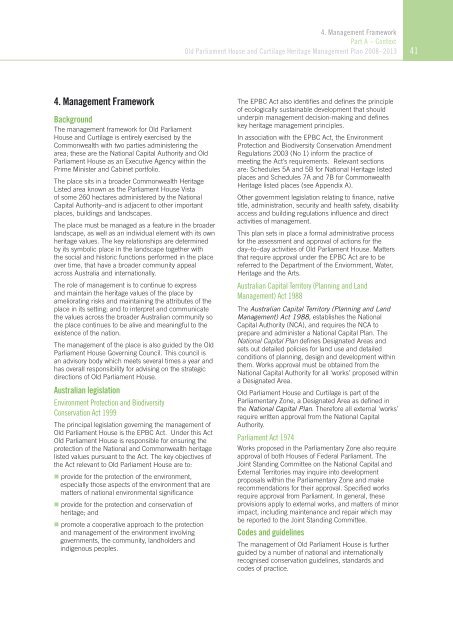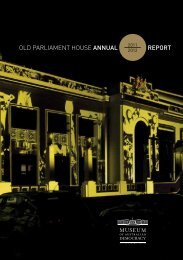OLD PARLIAMENT HOUSE AND CURTILAGE HERITAGE MANAGEMENT PLAN 2008–2013
Heritage Management Plan 2008-2013 - Museum of Australian ...
Heritage Management Plan 2008-2013 - Museum of Australian ...
- No tags were found...
You also want an ePaper? Increase the reach of your titles
YUMPU automatically turns print PDFs into web optimized ePapers that Google loves.
4. Management Framework<br />
Part A – Context<br />
Old Parliament House and Curtilage Heritage Management Plan <strong>2008–2013</strong><br />
41<br />
4. Management Framework<br />
Background<br />
The management framework for Old Parliament<br />
House and Curtilage is entirely exercised by the<br />
Commonwealth with two parties administering the<br />
area; these are the National Capital Authority and Old<br />
Parliament House as an Executive Agency within the<br />
Prime Minister and Cabinet portfolio.<br />
The place sits in a broader Commonwealth Heritage<br />
Listed area known as the Parliament House Vista<br />
of some 260 hectares administered by the National<br />
Capital Authority–and is adjacent to other important<br />
places, buildings and landscapes.<br />
The place must be managed as a feature in the broader<br />
landscape, as well as an individual element with its own<br />
heritage values. The key relationships are determined<br />
by its symbolic place in the landscape together with<br />
the social and historic functions performed in the place<br />
over time, that have a broader community appeal<br />
across Australia and internationally.<br />
The role of management is to continue to express<br />
and maintain the heritage values of the place by<br />
ameliorating risks and maintaining the attributes of the<br />
place in its setting; and to interpret and communicate<br />
the values across the broader Australian community so<br />
the place continues to be alive and meaningful to the<br />
existence of the nation.<br />
The management of the place is also guided by the Old<br />
Parliament House Governing Council. This council is<br />
an advisory body which meets several times a year and<br />
has overall responsibility for advising on the strategic<br />
directions of Old Parliament House.<br />
Australian legislation<br />
Environment Protection and Biodiversity<br />
Conservation Act 1999<br />
The principal legislation governing the management of<br />
Old Parliament House is the EPBC Act. Under this Act<br />
Old Parliament House is responsible for ensuring the<br />
protection of the National and Commonwealth heritage<br />
listed values pursuant to the Act. The key objectives of<br />
the Act relevant to Old Parliament House are to:<br />
• provide for the protection of the environment,<br />
especially those aspects of the environment that are<br />
matters of national environmental significance<br />
• provide for the protection and conservation of<br />
heritage; and<br />
• promote a cooperative approach to the protection<br />
and management of the environment involving<br />
governments, the community, landholders and<br />
indigenous peoples.<br />
The EPBC Act also identifies and defines the principle<br />
of ecologically sustainable development that should<br />
underpin management decision-making and defines<br />
key heritage management principles.<br />
In association with the EPBC Act, the Environment<br />
Protection and Biodiversity Conservation Amendment<br />
Regulations 2003 (No 1) inform the practice of<br />
meeting the Act’s requirements. Relevant sections<br />
are: Schedules 5A and 5B for National Heritage listed<br />
places and Schedules 7A and 7B for Commonwealth<br />
Heritage listed places (see Appendix A).<br />
Other government legislation relating to finance, native<br />
title, administration, security and health safety, disability<br />
access and building regulations influence and direct<br />
activities of management.<br />
This plan sets in place a formal administrative process<br />
for the assessment and approval of actions for the<br />
day–to–day activities of Old Parliament House. Matters<br />
that require approval under the EPBC Act are to be<br />
referred to the Department of the Enviornment, Water,<br />
Heritage and the Arts.<br />
Australian Capital Territory (Planning and Land<br />
Management) Act 1988<br />
The Australian Capital Territory (Planning and Land<br />
Management) Act 1988, establishes the National<br />
Capital Authority (NCA), and requires the NCA to<br />
prepare and administer a National Capital Plan. The<br />
National Capital Plan defines Designated Areas and<br />
sets out detailed policies for land use and detailed<br />
conditions of planning, design and development within<br />
them. Works approval must be obtained from the<br />
National Capital Authority for all ‘works’ proposed within<br />
a Designated Area.<br />
Old Parliament House and Curtilage is part of the<br />
Parliamentary Zone, a Designated Area as defined in<br />
the National Capital Plan. Therefore all external ‘works’<br />
require written approval from the National Capital<br />
Authority.<br />
Parliament Act 1974<br />
Works proposed in the Parliamentary Zone also require<br />
approval of both Houses of Federal Parliament. The<br />
Joint Standing Committee on the National Capital and<br />
External Territories may inquire into development<br />
proposals within the Parliamentary Zone and make<br />
recommendations for their approval. Specified works<br />
require approval from Parliament. In general, these<br />
provisions apply to external works, and matters of minor<br />
impact, including maintenance and repair which may<br />
be reported to the Joint Standing Committee.<br />
Codes and guidelines<br />
The management of Old Parliament House is further<br />
guided by a number of national and internationally<br />
recognised conservation guidelines, standards and<br />
codes of practice.




